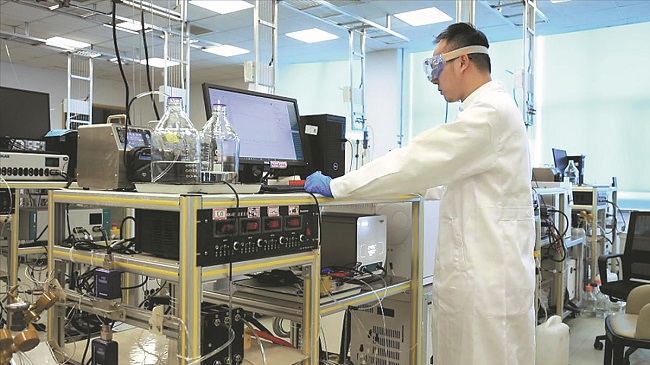
A researcher conducts carbon dioxide and carbon monoxide electrolysis tests at the Dalian Institute of Chemical Physics in Dalian, Liaoning province. CHINA DAILY
Chinese scientists have discovered a mechanism for converting carbon dioxide and carbon monoxide into chemicals and fuel via electrolysis, sources from the Dalian Institute of Chemical Physics of the Chinese Academy of Sciences said.
"The electrolysis of carbon dioxide and carbon monoxide can lead to the high value use of waste gases produced by steel plants and the incomplete industrial combustion of fossil fuels, which is being investigated as an effective way to achieve carbon neutrality, " said Wang Guoxiong, a professor at the DICP in Dalian, Liaoning province. "Electrolysis is a technique that uses direct electric current to drive a non-spontaneous chemical reaction, which replaces the oxygen in carbon dioxide and carbon monoxide with hydrogen from water, and enables them to be converted into products such as ethylene, acetic acid and ethanol," he said.
Wang said the study documents the highest performance among existing literature on the process, which means the new electrolyzer can produce the largest amount of ethylene, acetic acid and ethanol from carbon dioxide and carbon monoxide per unit time and per unit area. The study, led by DICP professors Bao Xinhe, Wang Guoxiong and Gao Dunfeng, was published in Nature Nanotechnology on Jan 12.
In it, the researchers investigated carbon dioxide and carbon monoxide co-electrolysis using a copper catalyst in an electrolyzer, an electrochemical device that uses electricity to convert the gases into multicarbon products at high current densities.
They specifically tuned the catalyst's microenvironment to use mixed carbon dioxide and carbon monoxide feeds that were typical of the composition of waste gases produced by steel plants and of the incomplete industrial combustion of fossil fuels.
By increasing carbon monoxide pressure in the feed, the electrolyzer gradually began to shift from producing ethylene to acetate, and the current density increased notably.
"This highlights the promise of tuning catalyst microenvironments for selective production of single multicarbon products at industrial current densities," Wang said. "Our study has laid a technical foundation for carbon dioxide and carbon monoxide electrolysis from the laboratory to practical application."